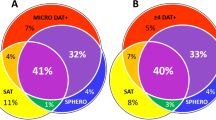Abstract
Biotin labeling of red cells was tested in dogs as a preclinical study for cell survival. Red cells were labeled with either spacered Biotin-X-NHS (BxNHS) or water-soluble biotin compounds. After reinfusion, biotinylated red cells were detected in small blood samples (5 μl) with flow cytometry. Improved BxNHS labeling allows an easy detection of positive red cells for almost 100 days, whereas labeling with watersoluble compounds – despite strong labeling during the first days – results in a decrease of label, which prevented a discrimation between labeled and negative cells after about 4 weeks. When biotin labeling of red cells was compared with 51Cr labeling, slopes of red cell survival were quite similar after the latter were corrected for elution. Survival slopes were linear, and the mean survival time was t=93d. In two blood-donor dogs the slopes of red cell survival where log linear and the mean survival time was t=45d. In conclusion, BxNHS, but not the water-soluble biotin compounds, is a good nonradioactive, nontoxic alternative for red cell survival studies. No health hazards are to be expected from the very low dose of Dimethylformamide, which is used as a solvent for biotin-x-NHS.
Similar content being viewed by others
Author information
Authors and Affiliations
Additional information
Received: 4 November 1996 / Accepted: 11 February 1997
Rights and permissions
About this article
Cite this article
Hoffmann-Fezer, G., Trastl, C., Beisker, W. et al. Preclinical evaluation of biotin labeling for red cell survival testing. Ann Hematol 74, 231–238 (1997). https://doi.org/10.1007/s002770050290
Issue Date:
DOI: https://doi.org/10.1007/s002770050290




